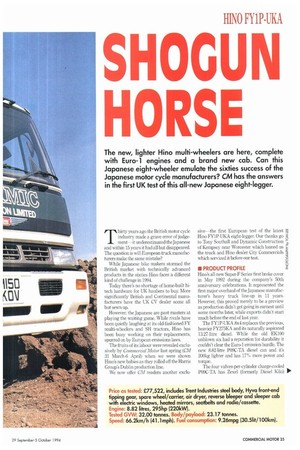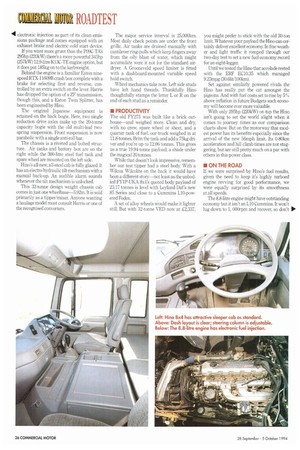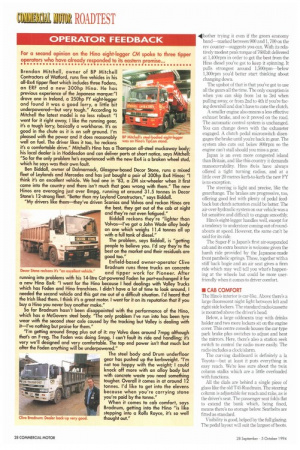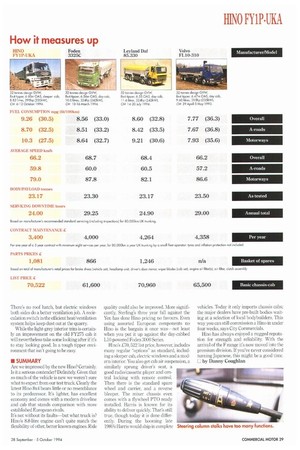S HO GU N
Page 27

Page 28

Page 30

Page 31

If you've noticed an error in this article please click here to report it so we can fix it.
HORS
The new, lighter Hino multi-wheelers are here, complete with Euro-1 engines and a brand new cab. Can this Japanese eight-wheeler emulate the sixties success of the Japanese motor cycle manufacturers? CM has the answers in the first UK test of this all-new Japanese eight-legger.
Thirty years ago the British motor cycle industry made a grave error of judgement--it underestimated the Japanese and within 15 years it had all but disappeared. The question is will European truck manufacturers make the same mistake?
While Japanese bike makers stormed the British market with technically advanced products in the sixties Hino faces a different kind of challenge in 1994.
Today there's no shortage of home-built hitech hardware for UK hauliers to buy More significantly British and Continental manufacturers have the UK CV dealer scene all but sewn up.
However, the Japanese are past masters at playing the waiting game. While rivals have been quietly laughing at its old-fashioned FY multi-wheelers and SH tractors, Hino has been busy working on their replacements, spurred on by European emissions laws.
The fruits of its labour were revealed exclusively by Commercial Motor last spring (CM 31 March-6 April) when we were shown Hino's new babies as they rolled off the Harris Group's Dublin production line.
We now offer CM readers another exclu sive—the first European test of the latest g Hino FY1P-UKA eight-legger. Our thanks go 6 to Tony Southall and Dynamic Construction 1, of Kempsey near Worcester which loaned us the truck and Hino dealer City Commercials which serviced it before our test.
• PRODUCT PROFILE Hino's all-new Super-F Series first broke cover in May 1992 during the company's 50th anniversary celebrations. It represented the first major overhaul of the Japanese manufacturer's heavy truck line-up in 11 years. However, this proved merely to be a preview as production didn't get going in earnest until some months later, while exports didn't start much before the end of last year.
The FY1P-UKA 8x4 replaces the previous, heavier FY275KA and its naturally aspirated 13.27-litre diesel. While the old EK100 unblown six had a reputation for durability it couldn't clear the Euro-1 emission hurdle. The new 8.82-litre PO9C-TA diesel can and it's 200kg lighter and has 17% more power and torque.
The four valves-per-cylinder charge-cooled PO9C-TA has Zexel (formerly Diesel Kiki) II electronic injection as part of its clean emissions package and comes equipped with an exhaust brake and electric cold start device. If you want more grunt than the PO9C-TA's 295hp (220k1A) there's a more powerful 345hp (257kW) 12.9-litre K 13C-TE engine option, but it does put 185kg on to the kerbweight.
Behind the engine is a familiar Eaton ninespeed RTX-11609B crash box complete with a brake for selecting first and reverse, controlled by an extra switch on the lever. Harris has dropped the option of a ZF transmission, though this, and a Eaton Twin Splitter, has been engineered by Hino.
The original Japanese equipment is retained on the back bogie. Here, two single reduction drive axles make up the 20-tonne capacity bogie with the old multi-leaf twospring suspension. Front suspension is now parabolic with a single anti-roll bar.
The chassis is a riveted and bolted structure. Air tanks and battery box are on the right while the 300-litre steel fuel tank and spare wheel are mounted on the left side.
Hino's all-new, all-steel cab is fully glazed. It has an electro-hydraulic tilt mechanism with a manual back-up. An audible alarm sounds whenever the tilt mechanism is unlocked.
This 32-tonne design weight chassis cab comes in just one wheelbase-5.92m, It is sold primarily as a tipper/mixer. Anyone wanting a haulage model must consult Harris or one of the recognised converters. The major service interval is 25,000km. Most daily check points are under the front grille. Air tanks are drained manually with cantilever ring-pulls which keep fingers away from the oily blast of water, which might accumulate were it not for the standard airdryer. A Groeneveld speed limiter is fitted with a dashboard-mounted variable speed hold switch.
Wheel mechanics take note. Left side studs have left hand threads. Thankfully Hino thoughtfully stamps the letter L or R on the end of each stud as a reminder.
• PRODUCTIVITY The old FY275 was built like a brick outhouse—and weighed more. Clean and dry, with no crew, spare wheel or sheet, and a quarter tank of fuel, our truck weighed in at 11.8-tonnes. Brim the tank and add a 75kg driver and you're up to 12.06 tonnes. This gives us a true 19.94-tonne payload: a shade under the magical 20 tonnes.
While that doesn't look impressive, remember our test tipper had a steel body. With a Wilcox Wilcolite on the back it would have been a different story—not least as the unbodied FY1P-UKA 8x4's quoted body payload of 23.17 tonnes is level with Leyland Daf's new 85 Series and close to a Cummins L10-powered Foden.
A set of alloy wheels would make it lighter still. But with 32-tonne VED now at £2,337, you might prefer to stick with the old 30-ton limit. Whatever your payload the Hino can certainly deliver excellent economy. In fine weather and light traffic it romped through our two-day test to set a new fuel economy record for an eight-legger.
Until we tested the Hino that accolade rested with the ERF EC10.35 which managed 923mpg (30.61it/1001cm).
Set against similarly powered rivals the Hino has really put the cat amongst the pigeons. And with fuel costs set to rise by 5% above inflation in future Budgets such economy will become ever more valuable.
With only 295hp (220kW) on tap the Hino isn't going to set the world alight when it comes to journey times as our comparison charts show. But on the motorway that modest power has its benefits especially since the arrival of the new 56mph limit. Its 0-80km acceleration and hill climb times are not staggering, but are still pretty much on a par with others in this power class.
• ON THE ROAD If we were surprised by Hino's fuel results, given the need to keep its highly turboed engine revving for good performance, we were equally surprised by its smoothness at all speeds.
The 8.8-litre engine might have outstanding economy but it isn't an L10 Cummins It won't lug down to 1, 000rpm and recover, so don't 00' libother trying it even if the green economy band—marked between 900 and 1, 700 on the rev counter—suggests you can. With its relatively modest peak torque of 7601bft delivered at 1,400rpm in order to get the best from the Hino diesel you've got to keep it spinning. It pulls strongest around 1,500rpm—below 1,300rpm you'd better start thinking about changing down.
The upshot of that is that you've got to use all the gears all the time. The only exception is when you can skip from 1st to 3rd when pulling away, or from 2nd to 4th if you're facing downhill and don't have to cane the clutch.
A smaller engine also means a less effective exhaust brake, and so it proved on the road. The automatic control system is unchanged. You can change down with the exhauster engaged. A clutch pedal microswitch disengages the brake until you're back in gear. The system also cuts out below 800rpm so the engine can't stall should you miss a gear.
Japan is an even more congested island than Britain, and like this country it demands manoeuvrability. Hino 8x4s have always offered a tight turning radius, and at a little over 20 metres kerb-to-kerb the new FY is no exception.
The steering is light and precise, like the gearchange. The brakes are progressive, too, offering good feel with plenty of pedal feedback but clutch actuation could be better. The air-over-hydraulic system on our vehicle was a bit sensitive and difficult to engage smoothly Hino's eight-legger handles well, except for a tendency to understeer coming out of roundabouts at speed. However, the same can't be said for its ride.
The Super-F is Japan's first air-suspended cab and its extra bounce is welcome given the harsh ride provided by the Japanese-made front parabolic springs. These, together with a stiff back bogie and an air seat gives a firm ride which may well tell you what's happening at the wheels but could be more userfriendly when it comes to driver comfort.
• CAB COMFORT The Hino's interior is car-like. Above there's a large fluorescent night light between left and right side lockers. The standard radio/cassette is mounted above the driver's head.
Below a large oddments tray with drinks holder and two more lockers sit on the engine cover. This centre console houses the car-type park brake plus switches to adjust and heat the mirrors. Here, there's also a station seek switch to control the radio more easily. The radio includes a clock/alarm The curving dashboard is definitely a la Toyota—but at least it puts everything in easy reach. We're less sure about the twin column stalks which are a little overloaded with functions.
All the dials are behind a single piece of glass like the old T45 Roadtrain. The steering column is adjustable for reach and rake, as is the driver's seat. The passenger seat folds flat to extend the bunk which, being fixed, means there's no storage below. Seatbelts are fitted as standard.
Visibility is good, helped by the full glazing. The pedal layout will suit the largest of boots. There's no roof hatch, but electric windows both sides do a better ventilation job. A recirculation switch in the efficient heat/ventilation system helps keep dust out at the quarry.
While the light-grey interior trim is certainly an improvement on the old FY275 cab it will nevertheless take some looking after if it's to stay looking good. In a tough tipper environment that isn't going to be easy
• SUMMARY
Are we impressed by the new Hino? Certainly. Is it a serious contender? Definitely. Given that so much of the vehicle is new we weren't sure what to expect from our test truck. Clearly the latest Hino 8x4 bears little or no resemblance to its predecessor. It's lighter, has excellent economy and comes with a modern driveline and cab that stands comparison with more established European rivals.
It's not without its faults-but what truck is? Hino's 8.8-litre engine can't quite match the flexibility of other, better known engines. Ride quality could also be improved. More significantly, Sterling's three year fall against the Yen has done Hino pricing no favours. Even using assorted European components no Hino is the bargain it once was-not least when you put it up against the day-cabbed L10-powered Foden 3(X)0 Series.
Hino's .f 70, 522 list price, however, includes many regular "options" as standard, including a sleeper cab, electric windows and a modern interior. You also get cab all suspension, a similarly sprung driver's seat, a good radio/cassette player and central locking with remote control. Then there is the standard spare wheel and carrier, and a reverse bleeper. The mixer chassis even comes with a flywheel PT() ready installed, Harris is known for its ability to deliver quickly That's still true, though today it is done differently. During the booming late 1980's Harris would ship in complete vehicles. Today it only imports chassis cabs; the major dealers have pre-built bodies waiting at a selection of local bodybuilders. This way you can still commission a Hino in under four weeks, says City Commercials.
Hino has always enjoyed a rugged reputation for strength and reliability. With the arrival of the F-range it's now moved into the premium division. If you've never considered turning Japanese, this might be a good time. LI by Danny Coughlan




























































































